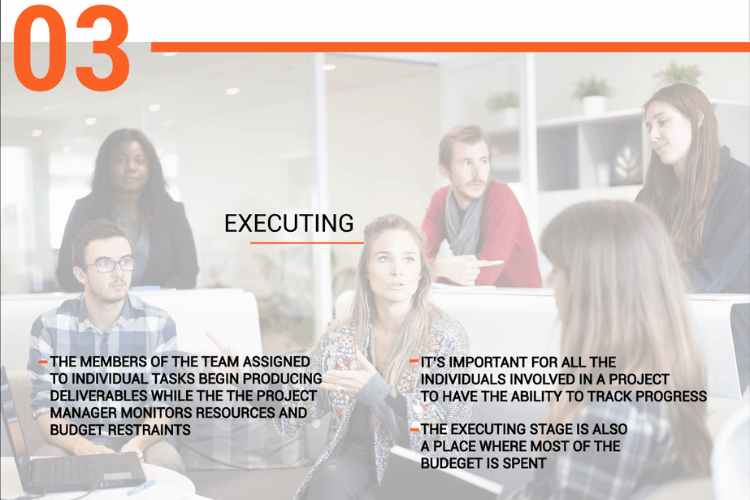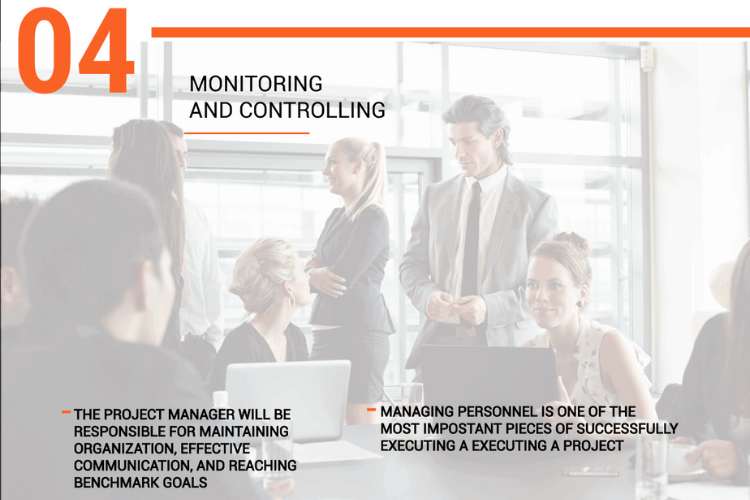The 5 Main Project Management Process Groups
Published:
Updated:

In the field of project management, there are two main categories that every project manager will require mastery of in order to succeed: knowledge areas and project management process groups. These two categories are the backbone of the PMBOK® Guide.
Key Takeaways
- Initiating: This phase involves defining the project and obtaining necessary approvals. It sets the foundation by outlining objectives, scope, and stakeholders.
- Planning: Detailed planning is crucial for project success. This phase includes developing schedules, budgets, resources, and risk management strategies to ensure project goals are achievable.
- Executing: During execution, the project plan is put into action. This involves coordinating people and resources, managing stakeholder expectations, and delivering project deliverables.
- Monitoring and Controlling: Continuous tracking of project performance against the plan is essential. This phase ensures any deviations are identified and corrected promptly, maintaining project alignment with objectives.
- Closing: The final phase involves formally closing the project, ensuring all deliverables are completed, and obtaining stakeholder acceptance. Lessons learned are documented for future reference.
In order to successfully pass the PMP Exam, you must become proficient in both of these areas. The knowledge areas consist of 10 different categories of project management that deal with all you must know in order to be a successful PM. The process groups are the methods by which you actually do the project management.
Learning about project management process groups and implementing them is not quite the same thing. Every project is unique, and so the implementation of process groups will necessarily be molded and shaped to fit your project in order for it to be successful. This article will discuss the basic principles of the 5 project management process groups which are project initiation, planning, execution, monitoring and controlling, and closing.

1. Initiating
The first step of any project involves casting a vision for what will be accomplished throughout the duration of that project. Without this step in the process, there is no groundwork laid, and a foundation is crucial for the building of anything, including successful projects. Initiation creates a strong foundation upon which the other four project management process groups are built.
During this stage, the project is formally authorized by the sponsoring company or organization. This includes making sure the broader vision of the project aligns with the vision of the company or organization.
The initial scope of the project is laid out and defined. As well, stakeholders are identified, as a critical part of the ongoing health of the project. Keeping the stakeholders informed as the project moves forward is an important component of project management.
This stage also includes establishing the phases of the project, organizing teams, acquiring necessary permits and setting initial work orders in place. The project manager will be responsible for identifying risk, needed resources, dependencies, objectives, timelines, and scopes and deliverables.
In short, project initiation is the set of steps required to successfully set a project in motion.

2. Planning
Within the PMBOK Guide, 24 different processes are defined as being part of the larger process of planning. Not all of these processes will necessarily be used in every project, but as you can see, this portion of a project involves more than just a cursory overview of the project before getting started.
In order to successfully move to the third project management process group (execution), you must first build a successful plan. Much of what is accomplished in this phase is taking the broader ideas established within the initiating stage and fleshing them out in greater detail.
Areas considered while making a plan:
- Defining the scope of the project in greater detail (including risks, milestones, summaries and budgets).
- Selecting teams and team leaders.
- Setting plans in place to maximize workflow in all areas of the project.
- Developing a project schedule (this will often involve the use of Gantt Charts).
- Giving the project the necessary infrastructure to achieve the goals of the project within the defined timeline and budgetary limitations.
- Establishing a communication plan for project team members and stakeholders (this will include selecting the project management software or apps you intend to use throughout the project.
Once a project manager has spent the time mapping out all of these details, he or she will assemble everything into a master document, or project management plan. This official document can be referred back to by all team members, stakeholders, and leaders throughout the project, and can be presented for final authorization and approval before officially beginning work on the project.

3. Executing
Oftentimes people are anxious to begin the work of a project and this will lead them to skip some planning to get to the execution phase, but this is unwise. With all of the planning details in place, a team can move forward into the execution stage with a clear, unified vision of all that needs to be accomplished.
During this project management process group, the members of the team assigned to individual tasks begin producing deliverables while the project manager monitors resources and budget restraints. With a detailed schedule in place, the team members will also be executing their tasks in the order needed by any dependencies between tasks.
The executing stage is also a place where most of the budget is spent, as well as where stakeholders may get involved and make changes or requests.
This is the phase during which reliable project management software can come in especially handy, as it can keep all members of the team communicating, and aware of any changes that need to be made. Especially with larger projects, it's important for all the individuals involved in a project to have the ability to track progress, and integrative software can help tremendously with that process.

4. Monitoring and Controlling
Throughout the timeline, the project manager will be responsible for maintaining organization, effective communication, and reaching benchmark goals. In short, they must monitor and control the project while it's being executed.
An effective project manager will also be able to assess and manage team members during this period, recognizing concerns or need for change, and effectively handling them, while keeping the project on track. Managing personnel is one of the most important pieces of successfully executing a project.
This project management process group relies heavily on the ability of the project manager to identify and troubleshoot problems as they arise, keeping the project on track and preventing it from stalling. During this stage, it's important to have a well-developed understanding of project risk management.
The manager must always have the scope of the project in view, by measuring the project's progress against projections and acting accordingly. By keeping the broader goals of the project in mind, while assessing the details of day-to-day operations, he or she can make sure goals are achieved and the project is successfully brought to completion.

5. Closing
Once a larger project's individual tasks are completed, the executing and monitoring and controlling project management process groups officially come to an end, and the project enters the process group known as Closing.
It may seem that it's all smooth sailing from here, but successfully closing out a project requires skill, and will reflect on a project manager's overall ability to lead a team and project.
To close out a project, the manager will need to do the following:
- Assemble a final report on all things accomplished during the project.
- Present the report to stakeholders or clients and acquire final approval and acceptance of the project.
- Tie up loose ends - this includes making final payments and closing contracts.
- Create a project closure report to establish how the project has performed against the original business plan for budget, timeline, and workflow.
- Create a lessons learned report - this involves assembling the team and discussing what was successful and what could be improved in future projects.
- Archive all reports and documents in an organized fashion for future reference.
Healthy closing reflects a healthy team. If a team grows disorganized in the end, with team members not showing up for meetings or final steps, it reflects poorly on the manager and on the company at large. It's important for the project manager to inspire a continuing strong work ethic in his or her team members up to the very end of the project.
The Importance of Project Management Process Groups
As project management continues to grow as a desirable position by companies in every type of industry, it's important for professional project managers to be familiar with the practice of these five main project management process groups. By knowing how to effectively initiate, plan, execute, monitor, and close a project, the project manager makes themselves valuable to a company.
When you familiarize yourself with the five project management process groups, you are aligning your skillset with proven tactics. This will only serve to deepen your knowledge as you lead projects and enable you to do so in the most efficient and successful way possible.
As you lead more projects, not only will your portfolio grow, but your knowledge and skill concerning process groups, as you gain the experience necessary to understand what works best and what doesn't.
Conclusion
Understanding and effectively implementing the five main project management process groups—Initiating, Planning, Executing, Monitoring, Controlling, and Closing—is crucial for any project’s success.
These phases provide a comprehensive framework that guides project managers in planning, executing, and delivering projects efficiently.

